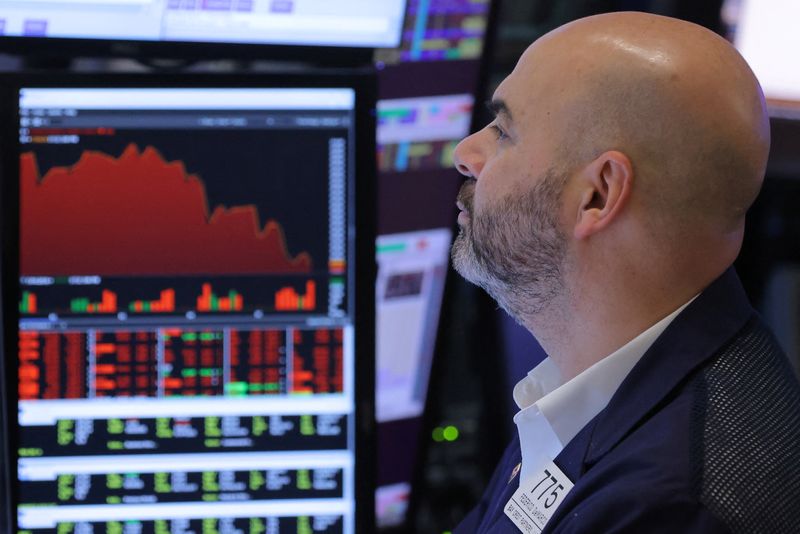By Lewis Krauskopf
NEW YORK (Reuters) - As the U.S. stock market ends a rocky first quarter, investors are looking at what could support equities in the coming months - with high cash levels at companies one potential boost as executives deploy resources for share buybacks, dividends or deals.
The S&P 500 posted its first quarterly loss since the beginning of the pandemic, although it rebounded in March, reducing the benchmark index's year-to-date decline to about 5% from as much as 12.5% at the quarter's low point.
The outlook for stocks is still threatened by rising interest rates as the Federal Reserve tightens monetary policy, as well as by spiking inflation and uncertainty over the war in Ukraine. The ability of companies to deploy cash could help soothe investors about some of that unease.
“While cash levels are off the highs from last year, they are still well above the pandemic levels and remain supportive for buybacks, dividends and M&A, which are all shareholder friendly activities,” said Keith Lerner, co-chief investment officer at Truist Advisory Services.
Company plans to deploy their cash could become more clear in the coming weeks as they report first-quarter results, which are expected to show a 6.4% increase in S&P 500 company profits, according to Refinitiv IBES.
Cash levels have risen as companies were cautious spenders during the pandemic, while corporate cash flow margins have been expanding in the past decade, strategists said.
Since peaking at just over $2 trillion in early 2021, cash on S&P 500 company balance sheets has dipped to about $1.9 trillion, according to Truist. But that remains well above $1.5 trillion, where it stood at the end of 2019 before the pandemic.
“Cash levels, whether it’s cash on balance sheets or even the ability of companies to tap capital markets if necessary, remain very robust,” said Patrick Palfrey, a senior equity strategist at Credit Suisse (SIX:CSGN).
In a recent report titled "The bull case for stocks," Credit Suisse strategists said they "would expect both buybacks and dividends to increase over the next 12-24 months, a boost to EPS and share prices."
S&P 500 company share buybacks came in at $881.7 billion in 2021, a record amount and up nearly 70% from 2020, according to S&P Dow Jones Indices.
The amount of announced buybacks this year has been tracking ahead of last year, according to TrimTabs, with $298.9 billion announced as of March 29, compared to $269.8 billion at that point a year ago.
Goldman Sachs (NYSE:GS) projects that corporations will be the largest source of equity demand in 2022. The bank this month raised its 2022 S&P 500 forecast for buybacks to $1 trillion.
"High cash balances and solid EPS growth will support robust corporate demand this year," Goldman said in a recent report.
Michael Arone, chief investment strategist at State Street (NYSE:STT) Global Advisors, said he doubted buybacks would be "big enough to either prevent a bear market or further fuel big gains in the stock market."
"However, it’s a nice steady tailwind to share prices if in fact share buybacks continue to be on pace for a record," Arone said. "It certainly helps, it’s a positive.”
U.S. President Joe Biden's 2023 budget plan, announced on Monday, took aim at buybacks, seeking to discourage corporations from using profits to repurchase stocks in order to benefit executives.
U.S. mergers and acquisitions totaled $2.5 trillion last year, the largest full-year period since records began in 1980, according to Refinitiv Deals Intelligence.
So far U.S. M&A has slowed versus last year, with activity down 20% to $516.8 billion from the same period a year ago, according to Deals Intelligence. Investors will be eager to see whether companies pick up the pace.
When it comes to use of cash, “M&A and buybacks are more volatile and they both signal a certain element of corporate executive confidence," Arone said. "Both are coming off record highs, so if that trend continues that should be a good sign for the markets.”
Some market watchers were wary of overstating the impact that large cash positions could have on the market.
For example, concerns about economic growth were set off anew this week when a closely watched part of the U.S. Treasury yield curve inverted, which has historically been a reliable signal of a looming recession. Indeed, that signal could make companies more cautious about deploying cash, some have said.
While having more cash on hand could help more companies survive an economic slowdown, it might not significantly stem stock declines, said Sameer Samana, senior global market strategist at Wells Fargo (NYSE:WFC) Investment Institute.
"More companies might make it through the next downturn but that doesn’t mean you couldn’t have a big pullback in stocks during the next downturn," Samana said.
